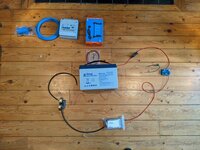
Just laying things out (I know its not a clear diagram but it helps me) to make sure i have everything in order before starting installing.
Am i missing anything?
I've also got the ablemail ams to connect in too (waiting of wiring kit), the loads from the Fuse box and sockets from consumer unit but that can wait another day.
Was thinking CU, battery charger and Ablemail under passenget seat with battery, battery protector, fuse box and smart shunt under drivers seat.
Any thoughts?


